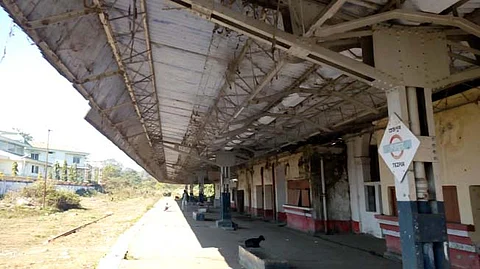Tezpur railway station: A remnant of heritage
Ranjan Kumar Padmapati
(The writer can be reached at rkpadmapati@yahoo.co.in)
The history of long-distance railway connectivity began with the Bengal Railways; the beginning was the company’s extended net work, a branch line up to Guwahati connecting the city to the eastern part of the country, in 1900. This was later extended to Tinisukia in 1902 and also to the existing line at the Dibrugarh-Sadiya track in 1903. Till that time, Tezpur Railway Station was not yet connected; only a branch line operated between Tezpur and Rangapara in isolation. In my childhood days, I frequented Sessa Tea Estate by the Rangapara-Tezpur shuttle train on many occasions and enjoyed the pleasing low-speed journey, hauled by black old steam engines, advancing amidst beautiful tea gardens on both sides, intermittently blowing iconic whistles specific to steam locomotives. The station is now almost abandoned, except for a computer reservation facility functioning in a small room. The whole station looks deserted and in disrepair.
The first-ever railway line came to Assam between Dibrugarh and Margherita in 1881, a distance of 65 km, established by the Assam Railway and Trading Company. Dibrugarh Railway Station was constructed in 1880, and in 1881, Dibrugarh Railway Workshop was established. The superintendent was W. Hollow. Makum is the oldest railway station in Assam. The other railway, known as the Tezpur-Balipara Steam Tram Way Company Ltd., was formed with a paid up capital of Rs 4 lakh and ran on a narrow gauge track. Fifty percent of it was raised in the tea gardens of the district of Darrang. It was a private railway. The purpose was to carry tea from tea gardens to the riverfront port adjacent to the station on the bank of the river Brahmaputra for onward shipments to Kolkata. Earlier, tea was transported to Steamer Ghat (river port) on bullock carts and returned with coal to tea gardens. The construction was quick. The first 8 miles (13 km) up to Bindukuri were completed by September 1894, then up to Sessa by November; the remaining up to Rangapara was completed by December 1894. The Borjuli Tea State extended two miles up to its factory. The Chief Commissioner of Assam, Henry Cotton, quoted in the Bengal Chamber of Commerce, ‘This tram way has got nice little branches to the gardens, and the branches go up to the tea house, and at the tea house, the tea is put on the train, and it is sent down to Tezpore.’ The company was given some concessions by the government, including free use of land by the side of the existing road and free timber from forests for sleepers, and a C.A. subsidiary of Rs. 5,000 per year by the local board. To reduce the cost of construction, the company had chosen 2 feet 6 inches of gauge amongst the three other options, viz., 2 feet, 2 feet 6 inches, and metre gauge.
The three locomotives of Type 4-4-0 and rolling stocks were purchased from Penny & Company and Brush Electrical Engineering Company. One of which was plunged into the Brahmaputra in an accident in 1895. Three more were introduced by W. G. Wagnall & Company between 1914 and 1925. These were working until 1981 in a sleeper depot in Clutterbuckganj near Bareilly. The top speed of the TBLR was 15 miles per hour. There were two passenger services per day in each day, but it was increased to three in 1934, and further added two services on bazaar days on Sundays because of a weekly big market at Bindukuri. The fares were in 1934 in the First Class, from Tezpur to Balipara, and back were rupees two, one ana, and six paisa. In the Third Class, seven ana and six paisa. The travel time up to Rangapra was one hour, forty-five minutes. The subsidy of Rs 5,000 was discontinued in 1913–14 onwards. Hugh Hughie wrote in 1907 that the line carried 157,000 passengers and 15,000 metric tonnes of freight, of which tea was 4203 metric tonnes, general merchandise was 5718 metric tonnes, and coal and coke totals amounted to 3015 metric tonnes. Arup Kumar Dutta recorded that the return in 1900–1910 was 5%, in 1911–20 it was 8%, and in 1943–44 it was 31%. It was taken over by the government, the Indian Railways, in 1952, and the track was converted to metre gauge. But after partition, the emergence of East Pakistan and subsequent wars stopped the stemmers paddling in the Brahmaputra totally, and the importance of Tezpur railway station gradually declined. With alternative expansion of railways, linking Kolkata became easier, transition delays were avoided, and goods movement became faster by train on this route. Rangapara Junction has taken over the place of Tezpur Railway Station.
After shifting the railway station to Dekargaon, a distance of 10 km, the whole track is lying idle now, and adjacent land owned by the government has been encroached upon. At the old station, on unused available land, a railway museum could be established where old engines and other items could be exhibited. In order to attract tourists, the unused track could be easily repaired to make it traffic-worthy, and nostalgic pleasure trips on the metre gauge up to Dekargaon could be reactivated. By doing so, a portion of the heritage track will thus be preserved as it is elsewhere in the country, and the ride would be an enjoyable heritage trip.

